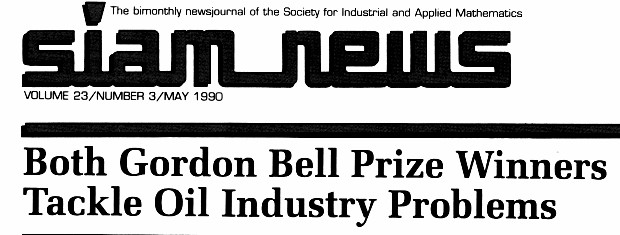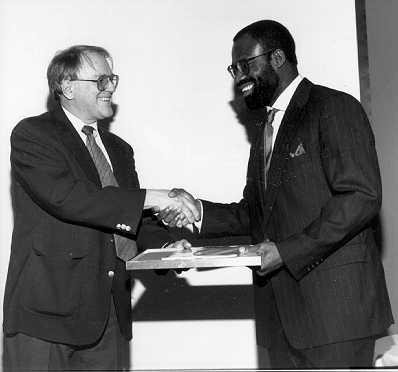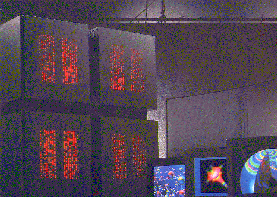

RELATED
The awards were presented in February at COMPCON, the
IEEE Computer Society's annual spring conference, held in San
Francisco. In addition to Karp, the judges were Jack Dongarra
(Oak Ridge National Laboratory), Ken Kennedy (Rice University),
and David Kuck (University of Illinois). ...
The implementation of a petroleum reservoir simulation (in general,
a system of multidimensional PDEs) on a massively parallel supercomputer
poses enormous mathematical and programming challenges:
The excessively small time-steps required by explicit finite-difference
models of oil reservoirs make such models highly inefficient.
Theoretical analysis has shown, however, that the magnitude of the
allowable time-steps is directly proportional to the
square root of the magnitude of the temporal inertial
force of the flowing fluid. In many practical situations the acceleration
force (the temporal and the convective inertial forces) is several
orders of magnitude smaller than the other forces and is therefore
neglected in the currently used reservoir equations.
Emeagwali's approach was to retain the original convective
inertial force and to increase the temporal inertial force
artificially. Surprisingly, increases of more than a thousand-fold
did not significantly reduce the accuracy of the model. In
fact, the stability of the explicit approximations used
to discretize the different governing equations was improved
drastically, making it possible to use time-steps of
several hours instead of a few seconds. In addition, the
resulting governing equations were hyperbolic rather than
parabolic.
In addition to the improved stability properties, the new formulation has
other good properties:
Interprocessor communication time is one of the main obstacles
to very high performance levels on massively parallel computers.
Emeagwali approached this problem by creating 128 "artificial,"
or virtual, processors within each of the CM's 65,536 physical
processors (a virtual processor ratio of 128). The challenge then
became one of decomposing and distributing the workload evenly
among the more than 8 million virtual processors.
Although in theory the number of virtual processors that
can be created is arbitrary, it is limited in practice by
the available memory, since the memory of each physical
processor is divided equally among the virtual processors.
Each instruction sent to a physical processor is repeated
once for each virtual processor within it. Performance does
not improve in proportion with the virtual processor ratio,
although the close physical location of data in the virtual
processors sharing the same memory reduces interprocessor
communication time.
To balance the workload evenly among processors, Emeagwali
used an array shape and dimensions that match the shape and
dimensions of the CM processor interconnection topology. The
"cshift" command was used to perform all required
interprocessor communications effectively. The grid point
calculations, which at that point consisted of simple scalar-matrix
operations, were then performed simultaneously with no further
interprocessor communication.
Inherent Parallelism
Oil reservoir simulation and a large class of seismic problems
are inherently parallel problems. The governing laws are the same
at all locations, and interactions are assumed to be local
over small times. Parallel computers operating in SIMD mode, as
demonstrated by this year's Gordon Bell Prize winners, are a
natural, efficient, and cost-effective processing tool for their
solution.
Click on emeagwali.com for more information.
+ + +
WEBSITES:
 Reservoir
modeling in the oil industry, important enough
that 10% of existing supercomputers are devoted to it, also played
a critical role in this year's Gordon Bell competition. In fact,
the applications in both of the winning entries --- one a seismic
model developed by a team from Mobil Research and Development
and Thinking Machines Corporation and the other an oil reservoir
simulation submitted by a graduate student from the University of
Michigan --- were problems from the oil industry. ...
Reservoir
modeling in the oil industry, important enough
that 10% of existing supercomputers are devoted to it, also played
a critical role in this year's Gordon Bell competition. In fact,
the applications in both of the winning entries --- one a seismic
model developed by a team from Mobil Research and Development
and Thinking Machines Corporation and the other an oil reservoir
simulation submitted by a graduate student from the University of
Michigan --- were problems from the oil industry. ...

Gordon Bell (left) congratulating Philip Emeagwali.
The Gordon Bell Prizes are designed to stimulate advances in
practical applications of parallel computing. ... The winner
in the price/performance category was Philip Emeagwali
of the University of
Michigan. Emeagwali's oil reservoir simulation model, also implemented
on the Connection Machine 2, achieved 365 megaflops per million dollars
--- a seven fold improvement over last year's winning entry.
"I have checked with several reservoir engineers who feel that his
calculation is of real importance and very fast," says Karp.
"His explicit method not only generates lots of megaflops, but solves problems
faster than implicit methods." Emeagwali is the first to
ave applied a pseudo-time approach in reservoir modeling,
according to Karp.

Click here for full-scale Connection Machine photograph

Reported in SIAM News, May 1990.


![]()